AASB 136 and Asset Impairment: Myer Business Group Analysis
VerifiedAdded on 2020/02/24
|9
|1677
|121
Report
AI Summary
This report examines the impairment of assets, using the Myer business group as a case study. It highlights the requirements of Accounting Standard AASB 136, which mandates the disclosure of impairment losses in financial reports. The report discusses the processes for identifying asset impairment through internal and external indicators, referencing the recent strategic changes Myer has undertaken to compete with Amazon. It details the evidence supporting impairment, the methods for determining impairment, the necessary information, and the flexibility management has in making impairment value determinations. The analysis includes the application of discounted cash flow models, assumptions used in calculations, and the handling of goodwill and intangible assets. The report aims to provide a comprehensive understanding of asset impairment in the context of financial reporting and business strategy.
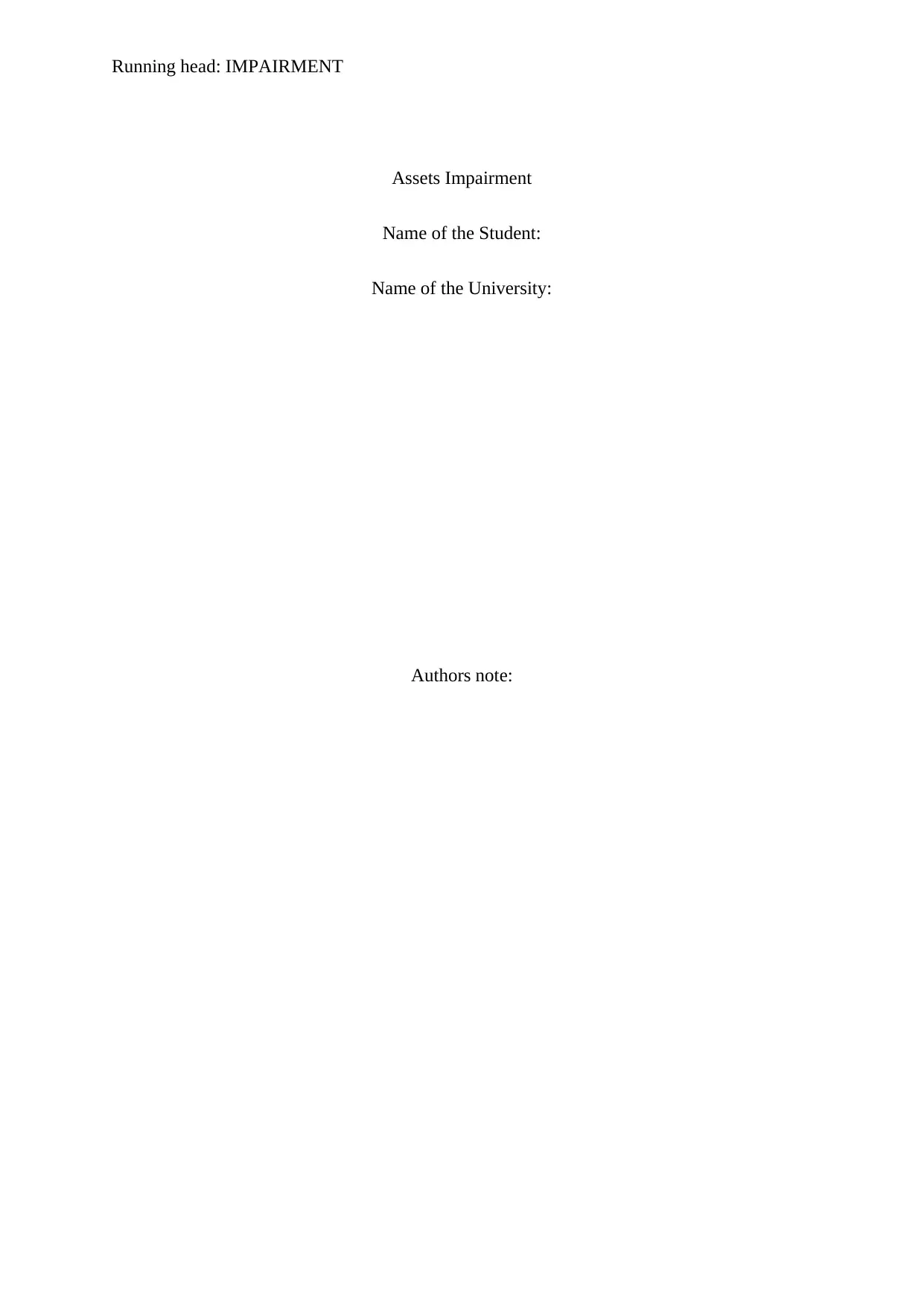
Running head: IMPAIRMENT
Assets Impairment
Name of the Student:
Name of the University:
Authors note:
Assets Impairment
Name of the Student:
Name of the University:
Authors note:
Paraphrase This Document
Need a fresh take? Get an instant paraphrase of this document with our AI Paraphraser
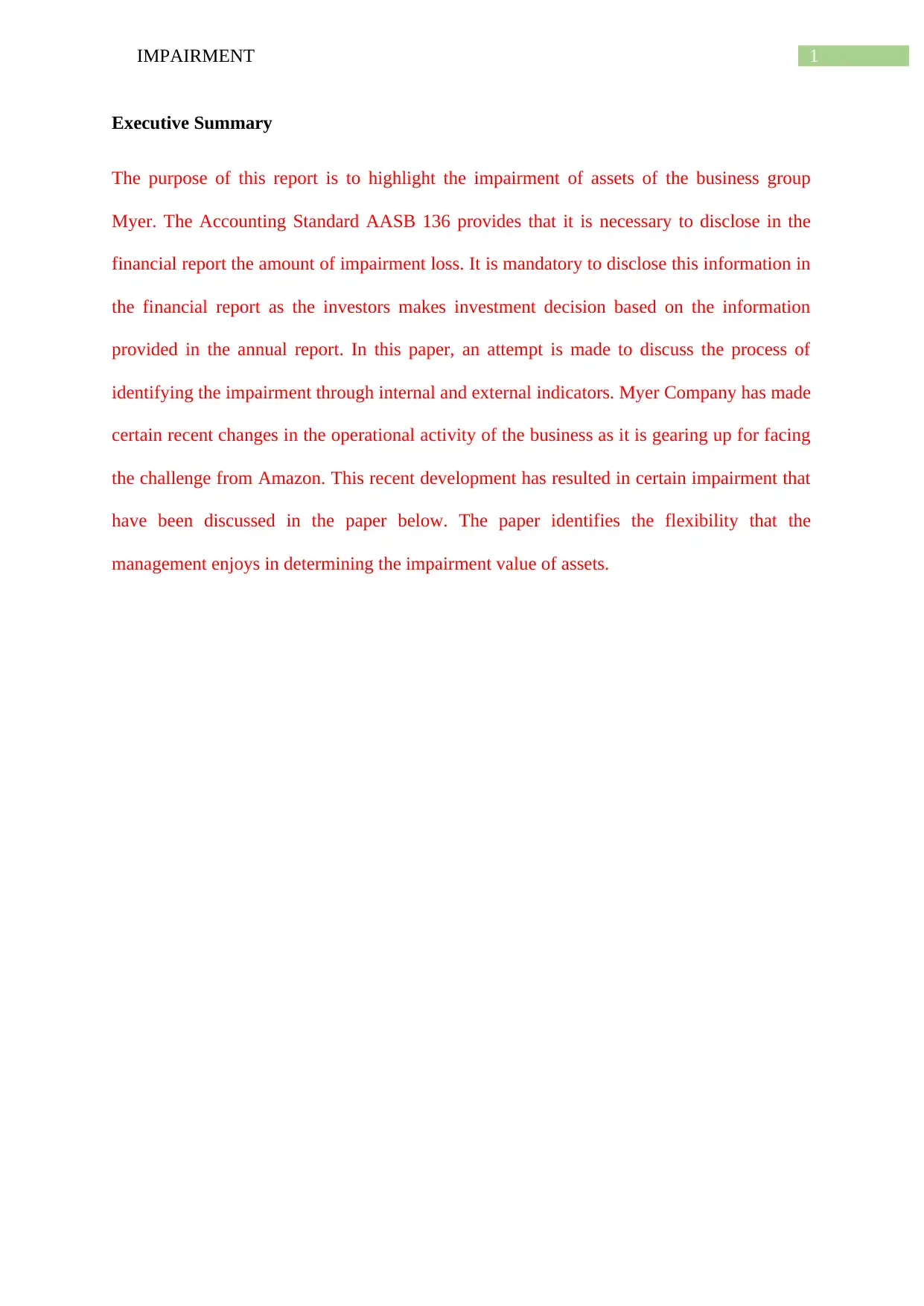
1IMPAIRMENT
Executive Summary
The purpose of this report is to highlight the impairment of assets of the business group
Myer. The Accounting Standard AASB 136 provides that it is necessary to disclose in the
financial report the amount of impairment loss. It is mandatory to disclose this information in
the financial report as the investors makes investment decision based on the information
provided in the annual report. In this paper, an attempt is made to discuss the process of
identifying the impairment through internal and external indicators. Myer Company has made
certain recent changes in the operational activity of the business as it is gearing up for facing
the challenge from Amazon. This recent development has resulted in certain impairment that
have been discussed in the paper below. The paper identifies the flexibility that the
management enjoys in determining the impairment value of assets.
Executive Summary
The purpose of this report is to highlight the impairment of assets of the business group
Myer. The Accounting Standard AASB 136 provides that it is necessary to disclose in the
financial report the amount of impairment loss. It is mandatory to disclose this information in
the financial report as the investors makes investment decision based on the information
provided in the annual report. In this paper, an attempt is made to discuss the process of
identifying the impairment through internal and external indicators. Myer Company has made
certain recent changes in the operational activity of the business as it is gearing up for facing
the challenge from Amazon. This recent development has resulted in certain impairment that
have been discussed in the paper below. The paper identifies the flexibility that the
management enjoys in determining the impairment value of assets.
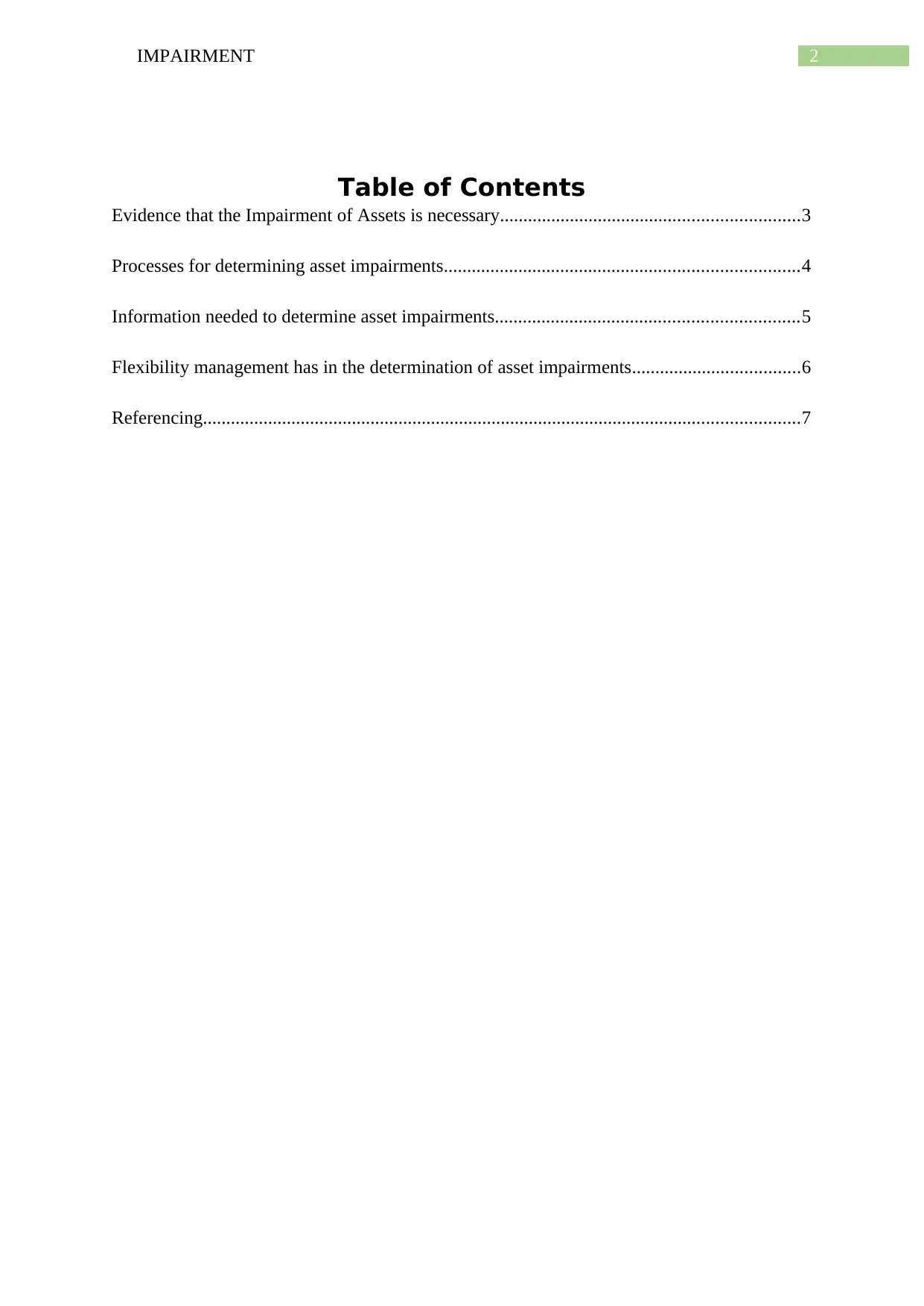
2IMPAIRMENT
Table of Contents
Evidence that the Impairment of Assets is necessary................................................................3
Processes for determining asset impairments............................................................................4
Information needed to determine asset impairments.................................................................5
Flexibility management has in the determination of asset impairments....................................6
Referencing................................................................................................................................7
Table of Contents
Evidence that the Impairment of Assets is necessary................................................................3
Processes for determining asset impairments............................................................................4
Information needed to determine asset impairments.................................................................5
Flexibility management has in the determination of asset impairments....................................6
Referencing................................................................................................................................7
⊘ This is a preview!⊘
Do you want full access?
Subscribe today to unlock all pages.

Trusted by 1+ million students worldwide
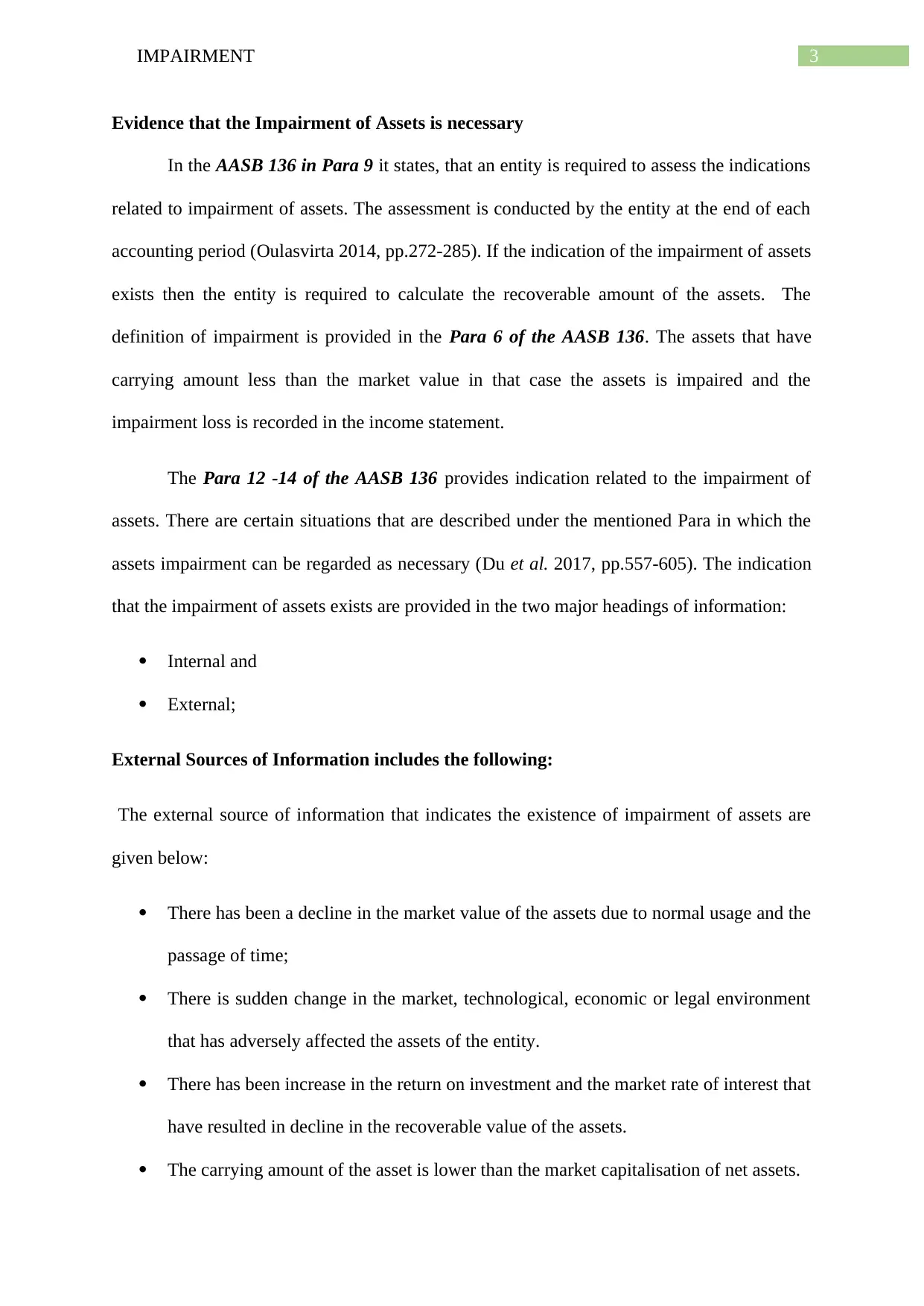
3IMPAIRMENT
Evidence that the Impairment of Assets is necessary
In the AASB 136 in Para 9 it states, that an entity is required to assess the indications
related to impairment of assets. The assessment is conducted by the entity at the end of each
accounting period (Oulasvirta 2014, pp.272-285). If the indication of the impairment of assets
exists then the entity is required to calculate the recoverable amount of the assets. The
definition of impairment is provided in the Para 6 of the AASB 136. The assets that have
carrying amount less than the market value in that case the assets is impaired and the
impairment loss is recorded in the income statement.
The Para 12 -14 of the AASB 136 provides indication related to the impairment of
assets. There are certain situations that are described under the mentioned Para in which the
assets impairment can be regarded as necessary (Du et al. 2017, pp.557-605). The indication
that the impairment of assets exists are provided in the two major headings of information:
Internal and
External;
External Sources of Information includes the following:
The external source of information that indicates the existence of impairment of assets are
given below:
There has been a decline in the market value of the assets due to normal usage and the
passage of time;
There is sudden change in the market, technological, economic or legal environment
that has adversely affected the assets of the entity.
There has been increase in the return on investment and the market rate of interest that
have resulted in decline in the recoverable value of the assets.
The carrying amount of the asset is lower than the market capitalisation of net assets.
Evidence that the Impairment of Assets is necessary
In the AASB 136 in Para 9 it states, that an entity is required to assess the indications
related to impairment of assets. The assessment is conducted by the entity at the end of each
accounting period (Oulasvirta 2014, pp.272-285). If the indication of the impairment of assets
exists then the entity is required to calculate the recoverable amount of the assets. The
definition of impairment is provided in the Para 6 of the AASB 136. The assets that have
carrying amount less than the market value in that case the assets is impaired and the
impairment loss is recorded in the income statement.
The Para 12 -14 of the AASB 136 provides indication related to the impairment of
assets. There are certain situations that are described under the mentioned Para in which the
assets impairment can be regarded as necessary (Du et al. 2017, pp.557-605). The indication
that the impairment of assets exists are provided in the two major headings of information:
Internal and
External;
External Sources of Information includes the following:
The external source of information that indicates the existence of impairment of assets are
given below:
There has been a decline in the market value of the assets due to normal usage and the
passage of time;
There is sudden change in the market, technological, economic or legal environment
that has adversely affected the assets of the entity.
There has been increase in the return on investment and the market rate of interest that
have resulted in decline in the recoverable value of the assets.
The carrying amount of the asset is lower than the market capitalisation of net assets.
Paraphrase This Document
Need a fresh take? Get an instant paraphrase of this document with our AI Paraphraser
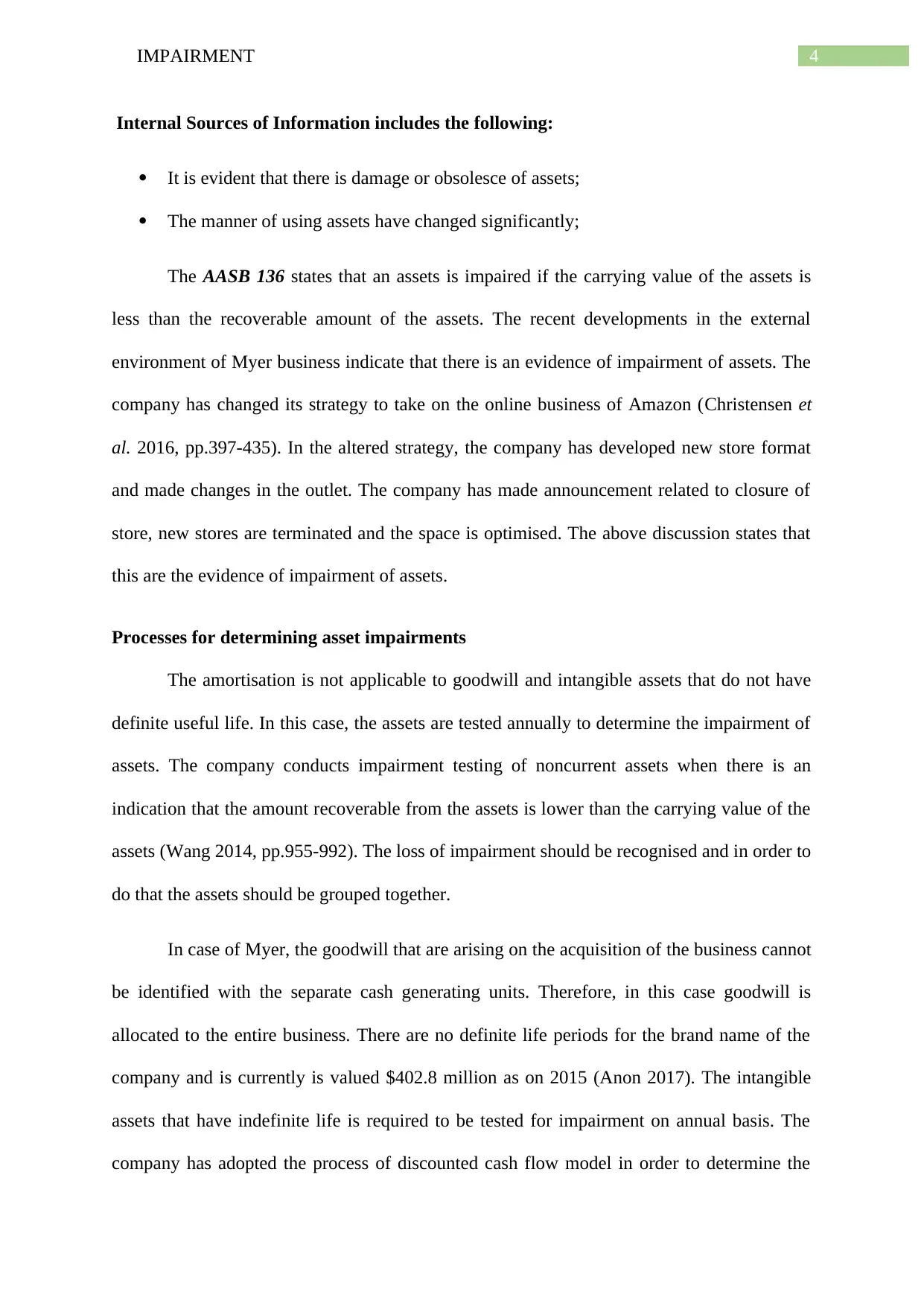
4IMPAIRMENT
Internal Sources of Information includes the following:
It is evident that there is damage or obsolesce of assets;
The manner of using assets have changed significantly;
The AASB 136 states that an assets is impaired if the carrying value of the assets is
less than the recoverable amount of the assets. The recent developments in the external
environment of Myer business indicate that there is an evidence of impairment of assets. The
company has changed its strategy to take on the online business of Amazon (Christensen et
al. 2016, pp.397-435). In the altered strategy, the company has developed new store format
and made changes in the outlet. The company has made announcement related to closure of
store, new stores are terminated and the space is optimised. The above discussion states that
this are the evidence of impairment of assets.
Processes for determining asset impairments
The amortisation is not applicable to goodwill and intangible assets that do not have
definite useful life. In this case, the assets are tested annually to determine the impairment of
assets. The company conducts impairment testing of noncurrent assets when there is an
indication that the amount recoverable from the assets is lower than the carrying value of the
assets (Wang 2014, pp.955-992). The loss of impairment should be recognised and in order to
do that the assets should be grouped together.
In case of Myer, the goodwill that are arising on the acquisition of the business cannot
be identified with the separate cash generating units. Therefore, in this case goodwill is
allocated to the entire business. There are no definite life periods for the brand name of the
company and is currently is valued $402.8 million as on 2015 (Anon 2017). The intangible
assets that have indefinite life is required to be tested for impairment on annual basis. The
company has adopted the process of discounted cash flow model in order to determine the
Internal Sources of Information includes the following:
It is evident that there is damage or obsolesce of assets;
The manner of using assets have changed significantly;
The AASB 136 states that an assets is impaired if the carrying value of the assets is
less than the recoverable amount of the assets. The recent developments in the external
environment of Myer business indicate that there is an evidence of impairment of assets. The
company has changed its strategy to take on the online business of Amazon (Christensen et
al. 2016, pp.397-435). In the altered strategy, the company has developed new store format
and made changes in the outlet. The company has made announcement related to closure of
store, new stores are terminated and the space is optimised. The above discussion states that
this are the evidence of impairment of assets.
Processes for determining asset impairments
The amortisation is not applicable to goodwill and intangible assets that do not have
definite useful life. In this case, the assets are tested annually to determine the impairment of
assets. The company conducts impairment testing of noncurrent assets when there is an
indication that the amount recoverable from the assets is lower than the carrying value of the
assets (Wang 2014, pp.955-992). The loss of impairment should be recognised and in order to
do that the assets should be grouped together.
In case of Myer, the goodwill that are arising on the acquisition of the business cannot
be identified with the separate cash generating units. Therefore, in this case goodwill is
allocated to the entire business. There are no definite life periods for the brand name of the
company and is currently is valued $402.8 million as on 2015 (Anon 2017). The intangible
assets that have indefinite life is required to be tested for impairment on annual basis. The
company has adopted the process of discounted cash flow model in order to determine the
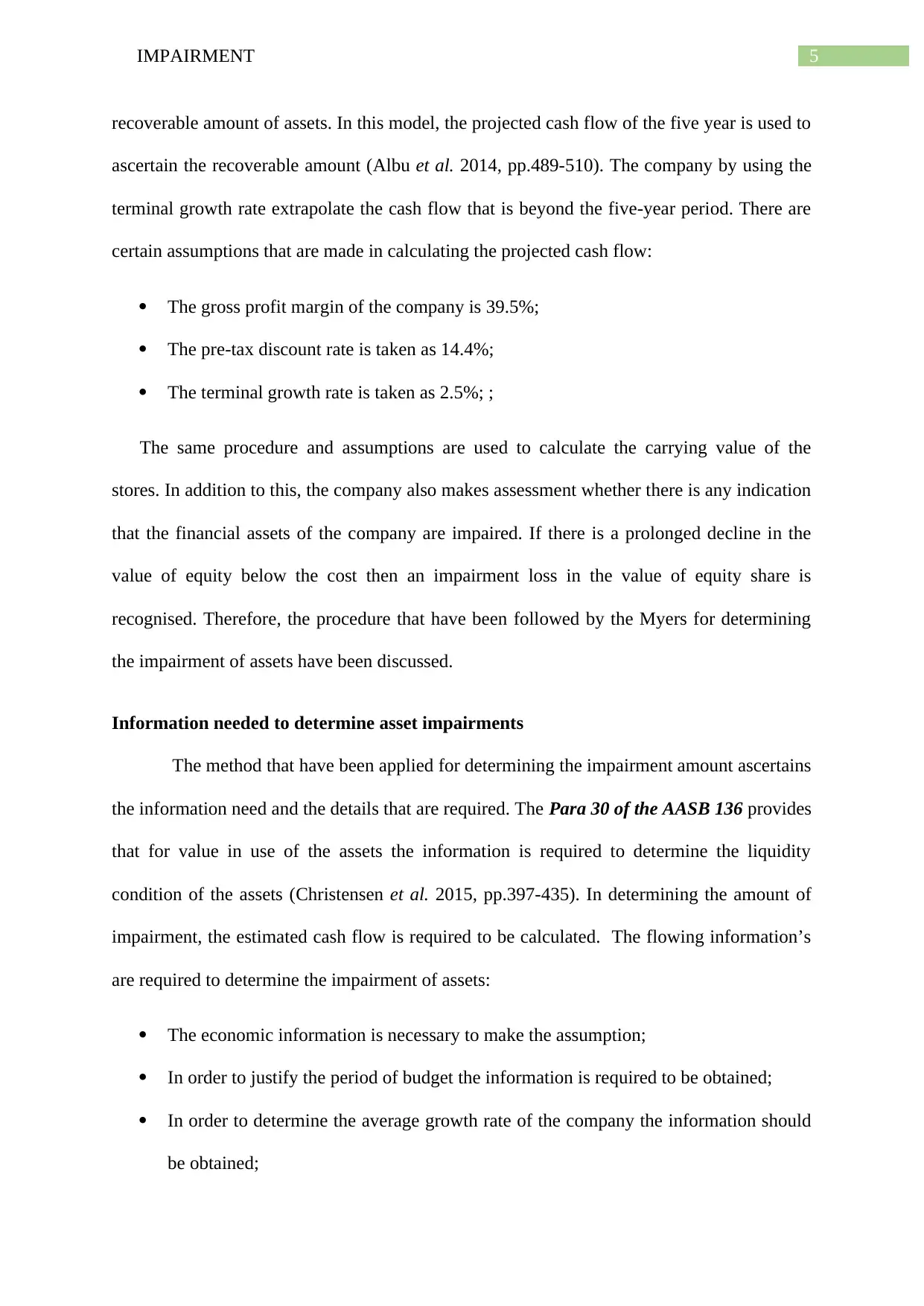
5IMPAIRMENT
recoverable amount of assets. In this model, the projected cash flow of the five year is used to
ascertain the recoverable amount (Albu et al. 2014, pp.489-510). The company by using the
terminal growth rate extrapolate the cash flow that is beyond the five-year period. There are
certain assumptions that are made in calculating the projected cash flow:
The gross profit margin of the company is 39.5%;
The pre-tax discount rate is taken as 14.4%;
The terminal growth rate is taken as 2.5%; ;
The same procedure and assumptions are used to calculate the carrying value of the
stores. In addition to this, the company also makes assessment whether there is any indication
that the financial assets of the company are impaired. If there is a prolonged decline in the
value of equity below the cost then an impairment loss in the value of equity share is
recognised. Therefore, the procedure that have been followed by the Myers for determining
the impairment of assets have been discussed.
Information needed to determine asset impairments
The method that have been applied for determining the impairment amount ascertains
the information need and the details that are required. The Para 30 of the AASB 136 provides
that for value in use of the assets the information is required to determine the liquidity
condition of the assets (Christensen et al. 2015, pp.397-435). In determining the amount of
impairment, the estimated cash flow is required to be calculated. The flowing information’s
are required to determine the impairment of assets:
The economic information is necessary to make the assumption;
In order to justify the period of budget the information is required to be obtained;
In order to determine the average growth rate of the company the information should
be obtained;
recoverable amount of assets. In this model, the projected cash flow of the five year is used to
ascertain the recoverable amount (Albu et al. 2014, pp.489-510). The company by using the
terminal growth rate extrapolate the cash flow that is beyond the five-year period. There are
certain assumptions that are made in calculating the projected cash flow:
The gross profit margin of the company is 39.5%;
The pre-tax discount rate is taken as 14.4%;
The terminal growth rate is taken as 2.5%; ;
The same procedure and assumptions are used to calculate the carrying value of the
stores. In addition to this, the company also makes assessment whether there is any indication
that the financial assets of the company are impaired. If there is a prolonged decline in the
value of equity below the cost then an impairment loss in the value of equity share is
recognised. Therefore, the procedure that have been followed by the Myers for determining
the impairment of assets have been discussed.
Information needed to determine asset impairments
The method that have been applied for determining the impairment amount ascertains
the information need and the details that are required. The Para 30 of the AASB 136 provides
that for value in use of the assets the information is required to determine the liquidity
condition of the assets (Christensen et al. 2015, pp.397-435). In determining the amount of
impairment, the estimated cash flow is required to be calculated. The flowing information’s
are required to determine the impairment of assets:
The economic information is necessary to make the assumption;
In order to justify the period of budget the information is required to be obtained;
In order to determine the average growth rate of the company the information should
be obtained;
⊘ This is a preview!⊘
Do you want full access?
Subscribe today to unlock all pages.

Trusted by 1+ million students worldwide
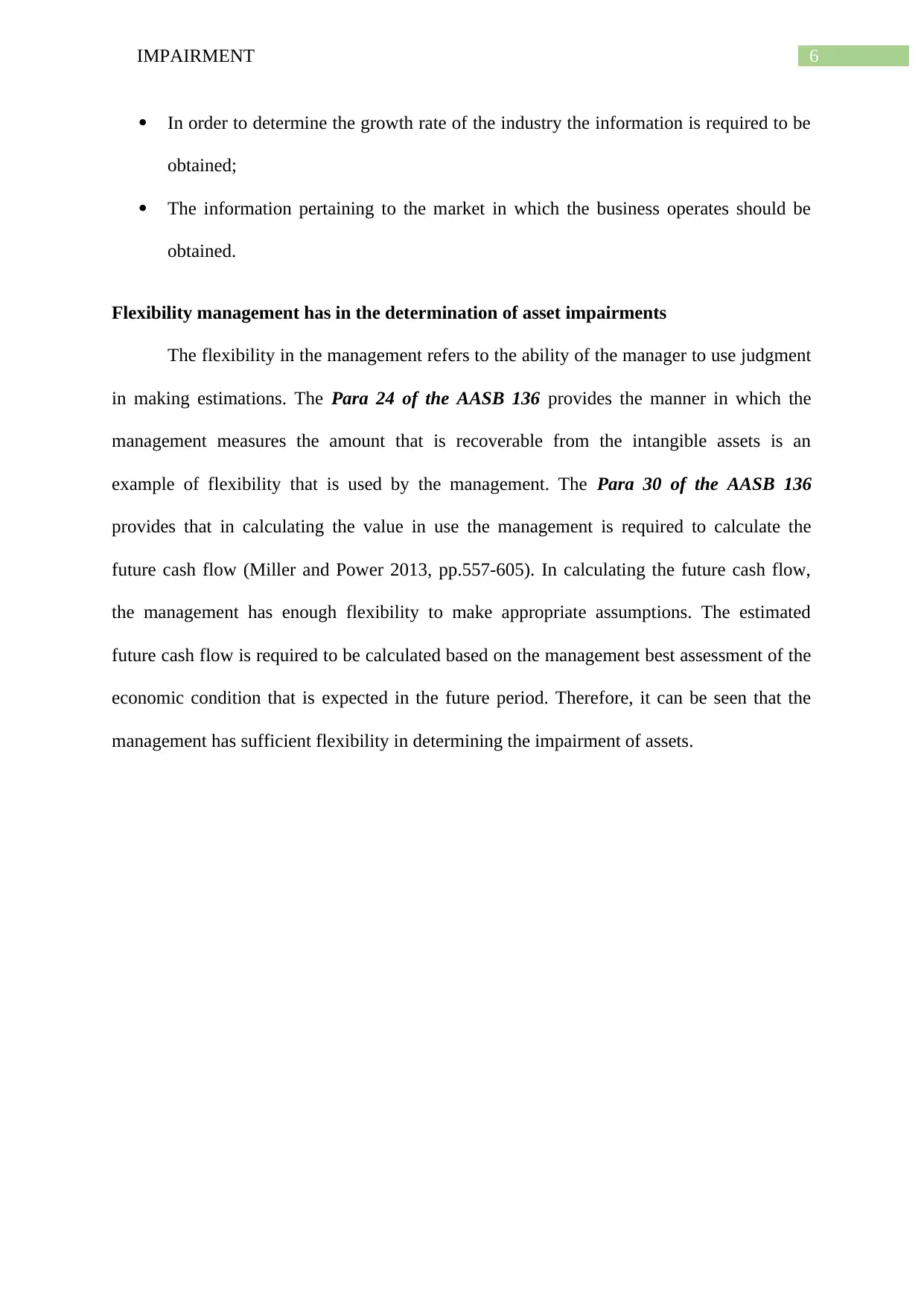
6IMPAIRMENT
In order to determine the growth rate of the industry the information is required to be
obtained;
The information pertaining to the market in which the business operates should be
obtained.
Flexibility management has in the determination of asset impairments
The flexibility in the management refers to the ability of the manager to use judgment
in making estimations. The Para 24 of the AASB 136 provides the manner in which the
management measures the amount that is recoverable from the intangible assets is an
example of flexibility that is used by the management. The Para 30 of the AASB 136
provides that in calculating the value in use the management is required to calculate the
future cash flow (Miller and Power 2013, pp.557-605). In calculating the future cash flow,
the management has enough flexibility to make appropriate assumptions. The estimated
future cash flow is required to be calculated based on the management best assessment of the
economic condition that is expected in the future period. Therefore, it can be seen that the
management has sufficient flexibility in determining the impairment of assets.
In order to determine the growth rate of the industry the information is required to be
obtained;
The information pertaining to the market in which the business operates should be
obtained.
Flexibility management has in the determination of asset impairments
The flexibility in the management refers to the ability of the manager to use judgment
in making estimations. The Para 24 of the AASB 136 provides the manner in which the
management measures the amount that is recoverable from the intangible assets is an
example of flexibility that is used by the management. The Para 30 of the AASB 136
provides that in calculating the value in use the management is required to calculate the
future cash flow (Miller and Power 2013, pp.557-605). In calculating the future cash flow,
the management has enough flexibility to make appropriate assumptions. The estimated
future cash flow is required to be calculated based on the management best assessment of the
economic condition that is expected in the future period. Therefore, it can be seen that the
management has sufficient flexibility in determining the impairment of assets.
Paraphrase This Document
Need a fresh take? Get an instant paraphrase of this document with our AI Paraphraser
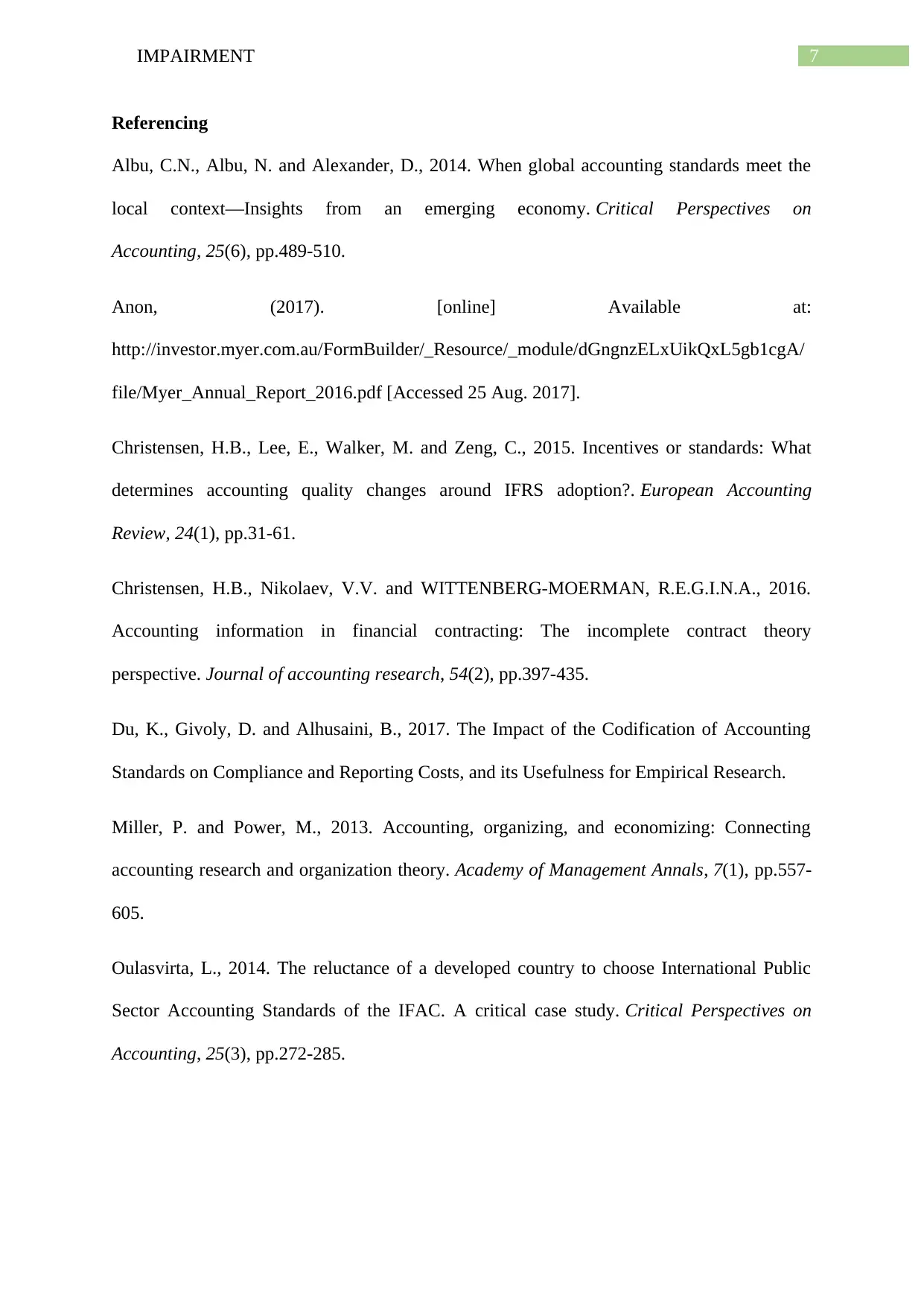
7IMPAIRMENT
Referencing
Albu, C.N., Albu, N. and Alexander, D., 2014. When global accounting standards meet the
local context—Insights from an emerging economy. Critical Perspectives on
Accounting, 25(6), pp.489-510.
Anon, (2017). [online] Available at:
http://investor.myer.com.au/FormBuilder/_Resource/_module/dGngnzELxUikQxL5gb1cgA/
file/Myer_Annual_Report_2016.pdf [Accessed 25 Aug. 2017].
Christensen, H.B., Lee, E., Walker, M. and Zeng, C., 2015. Incentives or standards: What
determines accounting quality changes around IFRS adoption?. European Accounting
Review, 24(1), pp.31-61.
Christensen, H.B., Nikolaev, V.V. and WITTENBERG‐MOERMAN, R.E.G.I.N.A., 2016.
Accounting information in financial contracting: The incomplete contract theory
perspective. Journal of accounting research, 54(2), pp.397-435.
Du, K., Givoly, D. and Alhusaini, B., 2017. The Impact of the Codification of Accounting
Standards on Compliance and Reporting Costs, and its Usefulness for Empirical Research.
Miller, P. and Power, M., 2013. Accounting, organizing, and economizing: Connecting
accounting research and organization theory. Academy of Management Annals, 7(1), pp.557-
605.
Oulasvirta, L., 2014. The reluctance of a developed country to choose International Public
Sector Accounting Standards of the IFAC. A critical case study. Critical Perspectives on
Accounting, 25(3), pp.272-285.
Referencing
Albu, C.N., Albu, N. and Alexander, D., 2014. When global accounting standards meet the
local context—Insights from an emerging economy. Critical Perspectives on
Accounting, 25(6), pp.489-510.
Anon, (2017). [online] Available at:
http://investor.myer.com.au/FormBuilder/_Resource/_module/dGngnzELxUikQxL5gb1cgA/
file/Myer_Annual_Report_2016.pdf [Accessed 25 Aug. 2017].
Christensen, H.B., Lee, E., Walker, M. and Zeng, C., 2015. Incentives or standards: What
determines accounting quality changes around IFRS adoption?. European Accounting
Review, 24(1), pp.31-61.
Christensen, H.B., Nikolaev, V.V. and WITTENBERG‐MOERMAN, R.E.G.I.N.A., 2016.
Accounting information in financial contracting: The incomplete contract theory
perspective. Journal of accounting research, 54(2), pp.397-435.
Du, K., Givoly, D. and Alhusaini, B., 2017. The Impact of the Codification of Accounting
Standards on Compliance and Reporting Costs, and its Usefulness for Empirical Research.
Miller, P. and Power, M., 2013. Accounting, organizing, and economizing: Connecting
accounting research and organization theory. Academy of Management Annals, 7(1), pp.557-
605.
Oulasvirta, L., 2014. The reluctance of a developed country to choose International Public
Sector Accounting Standards of the IFAC. A critical case study. Critical Perspectives on
Accounting, 25(3), pp.272-285.
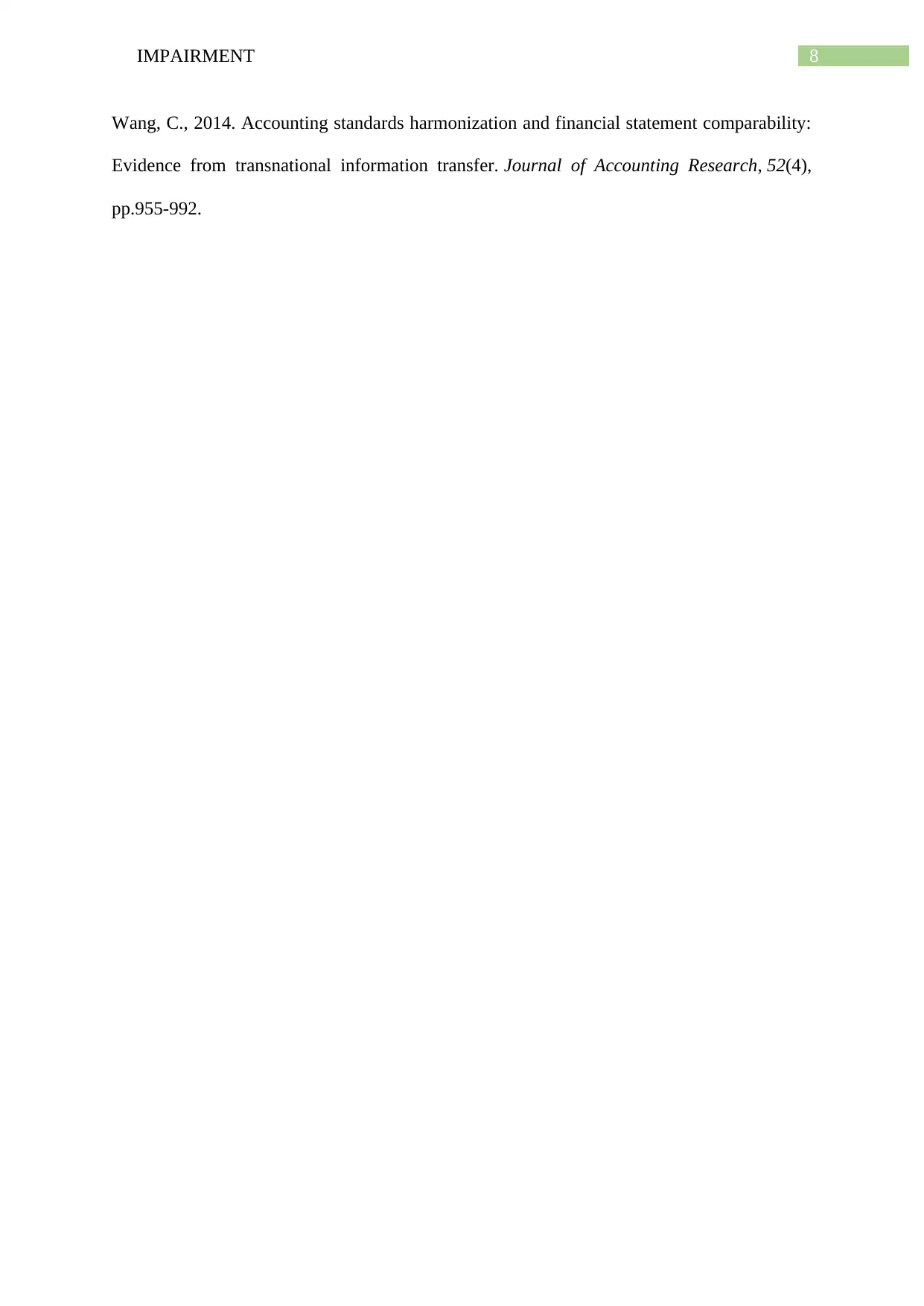
8IMPAIRMENT
Wang, C., 2014. Accounting standards harmonization and financial statement comparability:
Evidence from transnational information transfer. Journal of Accounting Research, 52(4),
pp.955-992.
Wang, C., 2014. Accounting standards harmonization and financial statement comparability:
Evidence from transnational information transfer. Journal of Accounting Research, 52(4),
pp.955-992.
⊘ This is a preview!⊘
Do you want full access?
Subscribe today to unlock all pages.

Trusted by 1+ million students worldwide
1 out of 9
Related Documents
Your All-in-One AI-Powered Toolkit for Academic Success.
+13062052269
info@desklib.com
Available 24*7 on WhatsApp / Email
![[object Object]](/_next/static/media/star-bottom.7253800d.svg)
Unlock your academic potential
Copyright © 2020–2025 A2Z Services. All Rights Reserved. Developed and managed by ZUCOL.





